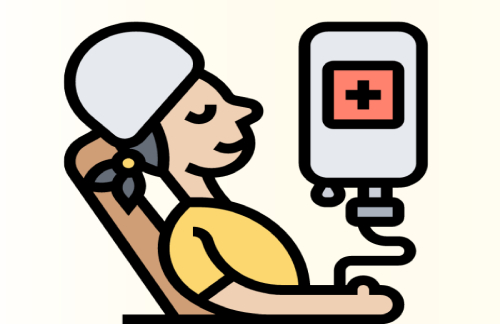
12 Nov, 2024

12 Nov, 2024

Medically reviewed by Dr. Manasi Shah, Consultant - Medical Oncology, HCG Cancer Centre, Ahmedabad on 5th April, 2024
Most cancer patients find their journey to be terrifying, not just because of the disease itself but also because of the impact of its treatment.
In the past, cancer management often meant facing aggressive treatments that came with unavoidable side effects.
Even though most of the side effects of cancer treatment are temporary, certain side effects can lead to psychological distress among cancer patients, and one of the most common ones to do so is hair loss after chemotherapy.
Hair loss due to chemotherapy can occur in patches, not just on the scalp but on other parts of the body, too. This can not only affect the patient’s confidence but may also affect their will to complete the treatment.
Over the years, we have discovered a few promising approaches that help reduce hair loss during chemotherapy. However, before learning about ways to reduce hair loss during chemotherapy, it is important to understand why chemotherapy causes hair loss.
“Chemotherapy hair loss is temporary. The hair usually starts growing back a few months after the chemotherapy has ended. However, some patients see hair loss as a scarring experience. For them, scalp cooling therapy can work wonders. Manasi Shah
Chemotherapy causes hair loss because it targets rapidly dividing cells in the body.
Hair follicle cells have a faster growth rate, making them a target for chemotherapy drugs. The hair follicles are responsible for hair growth, and when they are affected by chemotherapy drugs, they stop producing new hair, and existing hair fall out.
In recent times, scalp cooling, also known as scalp hypothermia or cooling cap therapy, has shown promising results in reducing hair loss during chemotherapy.
Scalp cooling therapy is a process where a cool cap or cooling device is placed on the head during chemotherapy to reduce the blood flow to the scalp.
Reduced blood flow brings down the amount of chemotherapy drugs that reach the hair follicles, which aids in reducing hair loss.
Scalp cooling is a simple and non-invasive method, and it may be recommended for different types of chemotherapy. Its biggest benefits include reduced hair loss, reduced emotional distress, and a confident and positive outlook on life.
Before recommending scalp cooling during chemotherapy, the expert team will carefully consider factors like the type of chemotherapy drugs being used, the dose, and the patient's overall health to check if a particular patient is the ideal candidate for scalp cooling therapy.
A scalp cooling cap for chemotherapy is placed sometime before the infusion starts. Patients are made to wear cooling caps or scalp cooling devices for a certain duration of time before, during, and after each cycle of chemotherapy.
Scalp cooling therapy uses cool temperatures during and after chemotherapy administration to prevent hair loss induced by powerful anti-cancer drugs.
The cooling cap worn during this procedure reduces the scalp temperature to about 18–22 degrees Celsius.
This cooling leads to the constriction of blood vessels. This constriction leads to reduced blood flow to the scalp, preventing the chemotherapy drugs from reaching the hair follicles.
The cooling cap for chemotherapy may be placed on the scalp 30 minutes before the treatment, which remains there throughout the treatment, and for 90 minutes to a few hours after the treatment.
Scalp cooling therapy is recommended for cancer patients undergoing chemotherapy for solid malignancies, namely breast cancer, ovarian cancer, prostate cancer, etc.
It is found to work for certain chemotherapy drugs only. Also, the patient must be otherwise healthy and not have any scalp conditions to undergo this procedure.
Some patients are not comfortable with extremely cool temperatures, and therefore, it is important to ensure that the patient is willing to undergo this process.
Scalp cooling therapy is a unique procedure used during chemotherapy treatment to control hair loss in the
scalp using cool temperatures.
Scalp cooling therapy reduces blood flow to the scalp, which in turn stops the chemotherapy drugs from
reaching the scalp.
Scalp cooling therapy is recommended for solid tumors only.
Several studies have been carried out to study the efficacy of scalp cooling therapy in patients with different types of cancer:
A study conducted in 2015 showed that the use of a scalp cooling cap appeared to be effective in preventing chemotherapy-induced alopecia in breast cancer patients undergoing adjuvant docetaxel and cyclophosphamide chemotherapy.
A 2017 research study found that female breast cancer patients in stages I to II who underwent chemotherapy using taxane, anthracycline, or a combination of both and used scalp cooling experienced a higher likelihood of retaining more than 50% of their hair after the fourth chemotherapy cycle compared to those who did not use a cold cap.
A research experiment conducted in 2019 found that utilizing a scalp-cooling device was effective in avoiding hair loss and was considered safe among Japanese patients. Additionally, the scalp cooling technique resulted in a quicker return of hair volume after chemotherapy, even in cases where it did not prevent hair loss caused by chemotherapy.
During chemotherapy, the expert team may use various techniques to administer scalp cooling, including:
Scalp cooling is not effective for all patients. The effectiveness of scalp cooling can depend on various factors, such as the type and stage of cancer, the type and dose of chemotherapy, the patient's hair type, and the patient's overall health.
Some studies have shown that scalp cooling can be effective in reducing hair loss in certain patients, while others have shown limited effectiveness.
Also, scalp cooling therapy is not recommended for patients undergoing treatment for blood cancers, such as leukemia, lymphoma, and myeloma. This is because there is a risk of cancer cells remaining in the scalp’s blood vessels.
To know if you are the right candidate for the scalp cooling process during your chemotherapy, you should talk to your expert team before the treatment.
Many studies have reported that scalp cooling is effective in reducing hair loss at varying degrees.
Cooling caps, ice packs, and scalp cooling device are the different approaches to administer scalp cooling
therapy during chemo treatments.
Scalp cooling is not recommended for blood cancers.
Like every other treatment, scalp cooling is associated with a few side effects. However, these are temporary and can be managed successfully.
Commonly observed side effects of scalp cooling include:
On rare occasions, patients may also experience blistering, skin redness, and irritation, and these adverse effects can be managed effectively.
Not all patients may experience these side effects, and the intensity of the side effects may vary from one patient to another.
For more information on the side effects of scalp cooling and its management, you may talk to your expert team.
The advent of scalp cooling has brought a glimmer of hope for cancer patients who previously had to suffer hair loss as a side effect of chemotherapy.
This innovative technique has been proven to be effective in preventing hair loss for many patients, and HCG – the Specialist in Cancer Care, one of the leading cancer hospitals in India, is at the forefront of offering this game-changing therapy to its patients.
Here is a video of one of our cancer warriors who underwent breast cancer treatment along with scalp cooling therapy:
With a commitment to using technology to improve the cancer journey, HCG is dedicated to making a difference in the lives of those affected by cancer. So, if you are undergoing chemotherapy and dreading hair loss, scalp cooling therapy could be something you may think of.
In recent years, cancer treatments have become more patient-centric, where it is not just the patient’s survival that is focused on but also the patient’s overall well-being.
Scalp cooling therapy is one such patient-centric approach where patients have reduced hair loss during their chemotherapy.
Patients with different cancer types can opt for this procedure and reduce their hair loss risk. This process does not come with any significant side effects, and hence, it is considered both safe and effective.
Efficacy of Scalp Cooling in Preventing Chemotherapy-Induced Alopecia in Breast Cancer Patients Receiving Adjuvant Docetaxel and Cyclophosphamide Chemotherapy: https://pubmed.ncbi.nlm.nih.gov/25749072/
Effect of a Scalp Cooling Device on Alopecia in Women Undergoing Chemotherapy for Breast Cancer: The SCALP Randomized Clinical Trial: https://pubmed.ncbi.nlm.nih.gov/28196254/
Efficacy of Scalp Cooling in Preventing and Recovering From Chemotherapy-Induced Alopecia in Breast Cancer Patients: The HOPE Study: https://pubmed.ncbi.nlm.nih.gov/31448235/

Dr. Manasi Shah
MBBS, American Board Certified in Internal Medicine, American Board Certified in Medical
Oncology and Hematology
Consultant – Medical Oncology
Dr. Manasi Shah is an experienced medical oncology consultant from HCG Cancer Centre, Ahmedabad, and she specializes in cancer management through systemic therapies. Her expertise lies in treating breast and gynecological malignancies, including ovarian, uterine, and cervical cancers, using chemotherapy, targeted therapy, immunotherapy, and hormone therapy. She is also a part of several national and international trials, working to improve the standard of care for cancer patients in India and to improve access to newer drugs.